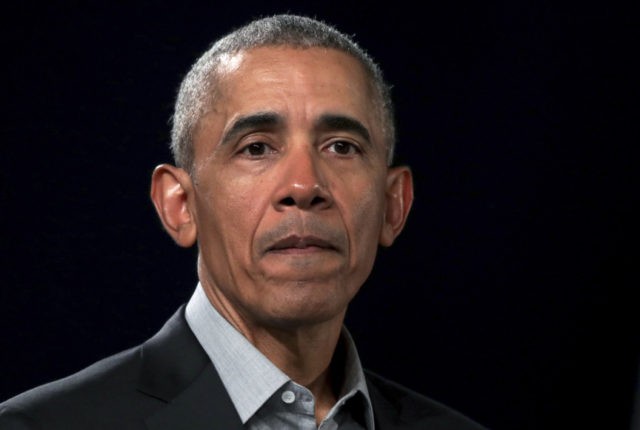Finally, we may have solved the mystery of how f
Post# of 128993

Finally, we may have solved the mystery of how former President Obama managed to drag the U.S. into the Paris Climate Accord – effectively a form of binding international treaty – without the necessary Congressional ratification. < >
Crooked cheating lying racist un American:

According to a lawsuit filed Monday, the Obama administration fudged the issue by misrepresenting U.S. Senate instructions set forth in 1992 to pretend that what was a treaty somehow wasn’t a treaty. The implication is that the Obama administration lied in order to railroad through a policy that it feared might get vetoed by Congress.
The case, brought by the public interest law firm Government Accountability & Oversight, centres on an Obama-era State Department Circular 175 memo.
The suit, on behalf of the nonprofit group Energy Policy Advocates (EPA), seeks records requested in June 2019, including the memorandum setting forth State’s “working law” claiming that the U.S. could enter Paris – what the Obama White House called “the most ambitious climate agreement in history” – without obtaining Senate approval required of treaties.
The complaint notes that EPA has come into possession of a document purporting to be theObama State Department’s “Circular 175” memo, a required legal justification which State has been improperly hiding from the public. GAO’s Chris Horner, co-author of a 2017 paper “TheLegal and Economic Case Against the Paris Treaty”, notes that:
If this document EPA has obtained is in fact the actual Circular 175 memo, it represents a major political and legal scandal with significant implications for U.S. participation in Paris, and the effort to bind the U.S. without following the Constitution.
This memo demonstrates the Obama administration’s unlawful entry into the Paris treaty.
Under the Constitution’s Article II, Section 2, no president can commit the U.S. to treaties without Senate advice and consent.
But on the previous occasion the U.S. was offered the chance to enter an international climate agreement under these Senate ground rules – the 1997 Kyoto Protocol – the Senate did not ratify it.
The Obama administration was anxious to avoid the Paris Climate Accord meeting the same rejection – and so sought ways to disguise the fact that what was billed as “the most ambitious climate change agreement in history” was also a treaty.
It did this, Government Accountability & Oversight’s Chris Horner argues, by sleight of hand:
This 18-page memo bases its argument that Paris need not face Article II, Section 2 “advice and consent” in key part on a gross and material misrepresentation of the history of prior climate agreements supposedly authorizing Pres. Obama’s unilateral “ratification” of Paris. The memo falsely asserts that the U.S. Senate, in ratifying the UN Framework Convention in 1992, limited agreements that “would need to be submitted to the Senate for advise and consent (Exec. Rept. 102-55, p. 14)” to those that claim to have “legally binding targets and timetables”. This is demonstrably false, and likely related to the secrecy with which State has treated this document.
Damningly, on this one point the advocacy-heavy “Memorandum of Law” curiously avoids quoting the cited page 14 of Exec. Rept. 102-55, “Report to Accompany Treaty Doc. 102-38”, which in fact says something very different. There the Senate clearly set forth two, distinct hypothetical agreements requiring Senate approval, one of which is any decision “to adopt targets and timetables” – not just those purporting to be “legally binding” (e.g., Kyoto, Paris).[1]
The mystery since 2015 of how the Obama administration skirted this reality is now solved: the memo legally justifying U.S. participation in the Paris Agreement without Senate approval misrepresents the U.S. Senate position. It did so by sleight-of-hand, in a parenthetical invention:
“‘targets and timetables’ [was] understood in that context to mean legally binding targets”[2].
This is unsupported, and in Rept. 102-55 the Senate used both terms deliberately, to describe two distinct scenarios: first, any decision “to adopt targets and timetables would have to be submitted to the Senate for its advice and consent before the United States could deposit its instruments of ratification for such an agreement”, which of course describes Paris; “further”, any attempt to convert the UNFCCC’s non-binding promise then before the Senate into “legally binding targets and timetables …would alter the ‘shared understanding’ of the Convention between the Senate and the executive branch and would therefore require the Senate’s advice and consent.”
In short, the Obama administration misrepresented the facts to involve the U.S. in Paris, and to avoid a repeat of the Kyoto “accord” which died when the Senate refused to even consider it.
President Trump confirmed last month that the U.S. is definitely pulling out of the Paris Accord. As is so often the way with these arrangements – see also: Brexit – it’s a lot easier to enter them than it is to exit them.
As Daily Caller reports:
Trump can finally make the pullout official Monday. The terms stipulate that a partnering country cannot withdraw within the first three years of submission. Trump can send a letter to the United Nations Monday announcing his intention. It won’t become official until one day after the 2020 election.
 (0)
(0) (0)
(0)